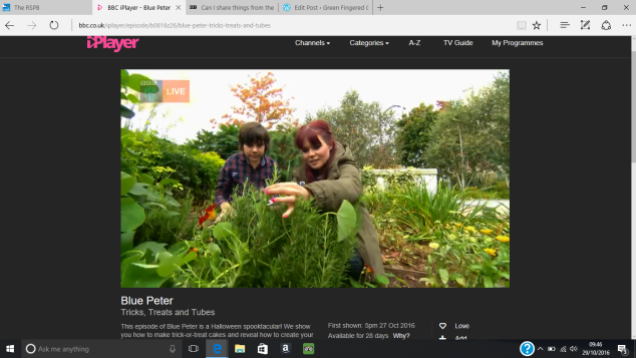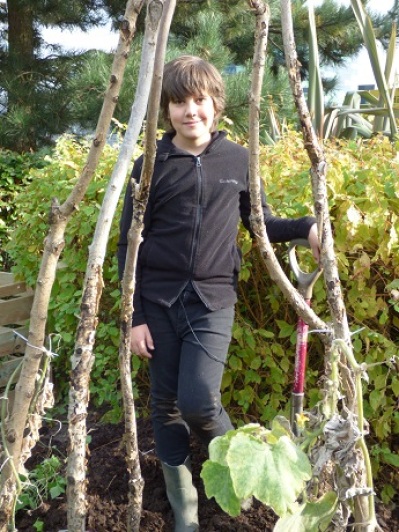I was well surprised to be awarded a ‘Silver’ Blue Peter Badge, for my work in the Blue Peter Garden
I was absolutely speechless!
It was great to revisit the Blue Peter Veg Patch & Garden to help harvest, clear up, start off a compost bin and meet a real life…..batman ! #Awesome
You can watch the clip here – it’s on at about 4 minutes and it’s available until 24th November 2016
Here’s the crew setting up, whilst me and Lindsay run through things. Check out me and my Dad sat in the Director’s chair #Action
Although we are coming to the end of the harvest there was still some runner beans left in the Blue Peter Garden and there’s some winter veg doing well too, including purple sprouting broccoli.
At home we have just picked the last of our courgettes, there’s apples and the sweetcorn is nearly ready – I can’t wait for that as it’s one of my favourite veggies.
A good tip from my gardening teacher, Sarah is to….
Harvest all the peas and beans you can, use or freeze them. Leave some on the plant to dry and use for seed next year. When you’re fed up of looking at the dried up plants, cut them at the base , don’t pull the plant out of the ground as the roots contain nodules (or white ish lumps) that hold clever bacteria that “fixes nitrogen” which is the science speak for turning a gas in the air into a food for the plants to eat easier. Nitrogen is one of the main plant foods that is good for leaf growth so if you leave this clever root system in the ground and come spring plant something such as brassicas or leafy salads you’ll have a bumper crop later !
Autumn clear up
Using gardening gloves, Lindsay and I carefully pulled some nettles out near the marigolds. When weeding and clearing up the beds in autumn, cut back any foliage that has died off and put in your compost area. Leave any seed heads for the birds to finish off and for insects to overwinter in. Try not to be too tidy as small piles of dead and decaying plant material is fab food and habitat for the wildlife, but any that you do clear up needs to go on the compost heap
Compost
Composting is the best part of Autumn, it turns left over plants and kitchen scraps into gorgeous compost. This is what I learnt about making compost in school gardening:
- Green ingredients- veg trimmings, any plant bits dead or alive, grass cuttings=nitrogen (the science bit)
- Brown ingredients- leaves, straw, eggshells, teabags, paper or cardboard chopped up or been through a shredder = carbon (the science bit) + plus water and air
- Throw in some minibeasts to chomp and mix and poo = compost
- Our double composter at school produced about 2 tonnes a year!
My gardening teacher, Sarah says……
If you have a compost heap , now is a good time to empty it and add to the beds. Not all plants like fresh compost when they start growing, but if you add the compost in the autumn it means it’s a little less vigourous for the new plants in spring, so I tend to improve all the beds with a good layer of compost. Left on the top it will gradually be taken down into the soil by the mini beasts and so be mixed in naturally. Its a great way to improve your veg patch soil
At home we garden organically and make our own comfrey feed, we put this on the veg patch, but beware it absolutely #Stinks !!!
Lindsay and I spread horse manure on the Blue Peter Garden and started off a compost area in the far left near the metal boat sculpture. The first thing in there was the nettles that we had pulled out from the veg patch
Hey I planted these flowers and veggies, back in May read my blog here and the crab apple tree looks great too – check out when I planted that here
After the gardening was all done it was time to meet a real life batman – he was actually called Steve and he was from the South Lancashire Bat Group. It was great to meet him as I’ve just done a blog all about bats in last weeks blog #WildAboutGardens
I asked Steve all about why we need to attract bats into our garden. He told us about the number of insects a bat can eat – over 500 tiny insects in one hour #Awesome! He showed us a common pipistrelle, which he is looking after – he will release it when it gets better. He told us bats can live between 10-20 years in the wild – amazing that isnt’ it.
Petra gets in the Halloween groove!
Night-scented plants are great for bats as they encourage moths into the garden and what’s a bats favourite meal, moths! It was an absolute pleasure to therefore plant a honeysuckle – I’ll look forward to visiting that in the coming years and the smell of the flowers is divine!
Here’s one of my favourite picture of me and ‘Batty’ Barney; he said he used to do this when he was a kid – personally, I think he still is a kid!
Once again I had a great time, the cast and crew are top people.
Cheers guys!
This wraps up my #WildAboutGardens Week and half-term – back to school tomorrow, boo-hoo!!
My next blog will be all about a fab day I had at RHS Garden Wisley


























Great advise as always George. Thanks for the tips!
LikeLike
you’re welcome Steve – are you clearing up in your garden ready for winter?
LikeLike
I am George, it’s been a lovely day weather wise today so I’ve done a last cut of my lawn & cut back some dead plant foliage. I ready! 😀
LikeLiked by 1 person
Pingback: ‘Here’s One I Made Earlier’ in the Blue Peter Garden | Green Fingered George